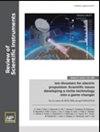中国空间站上的锶光学晶格时钟光学系统。
IF 1.7
4区 工程技术
Q3 INSTRUMENTS & INSTRUMENTATION
引用次数: 0
摘要
我们报道了一种用于中国空间站87Sr光学晶格时钟的紧凑型光学系统的设计和在轨演示。该系统采用紧凑而坚固的垂直堆叠结构,总容积为0.11 m3,质量为53.6 kg。它通过了热和振动测试,并在发射后保持全面运行。在轨道上,它实现了自动多级激光稳定和87Sr原子的蓝色磁光阱。这标志着在太空中操作光学时钟迈出了重要一步。本文章由计算机程序翻译,如有差异,请以英文原文为准。
Optical system for a strontium optical lattice clock aboard the Chinese Space Station.
We report the design and in-orbit demonstration of a compact optical system for a 87Sr optical lattice clock aboard the Chinese Space Station. This system adopts a compact and robust vertically stacked architecture with a total volume of 0.11 m3 and a mass of 53.6 kg. It passed thermal and vibration qualification tests and remained fully operational after launch. In orbit, it achieved automated multi-stage laser stabilization and a blue magneto-optical trap for 87Sr atoms. This marks a significant step toward operational optical clocks in space.
求助全文
通过发布文献求助,成功后即可免费获取论文全文。
去求助
来源期刊

Review of Scientific Instruments
工程技术-物理:应用
CiteScore
3.00
自引率
12.50%
发文量
758
审稿时长
2.6 months
期刊介绍:
Review of Scientific Instruments, is committed to the publication of advances in scientific instruments, apparatuses, and techniques. RSI seeks to meet the needs of engineers and scientists in physics, chemistry, and the life sciences.
 求助内容:
求助内容: 应助结果提醒方式:
应助结果提醒方式:


